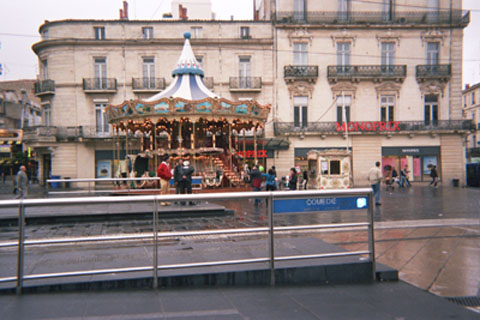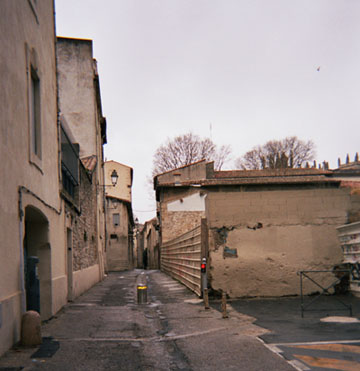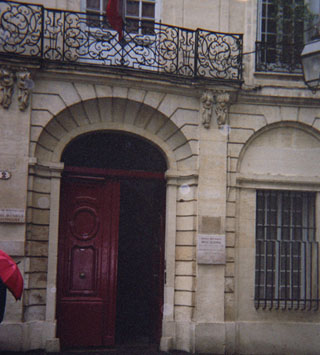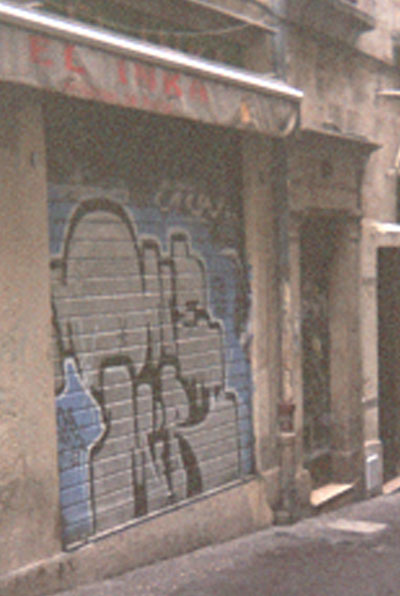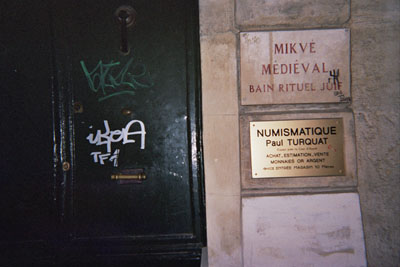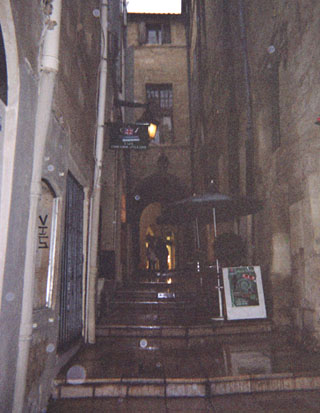French Travelogue
Montpellier, continued
March 23rd-27th,2005
. March 25, Friday: More on the Montpellier Youth Hostel. The population of the hostel can divided roughly into 3 categories. The largest group consisted elementary and high school children traveling on field trips during the Easter holidays. Because of them the rest of us were crowded into a few small rooms. Additional cots had to be added, which filled up most of the available floor space.
The next category contain persons placed in the hostel by social service agencies: homeless people, ex-convicts and a fair number of alcoholics. In terms of material for a work of fiction, one couldn't ask for better: imagine the possibilities of placing ex-cons and alcoholics together with groups of elementary school students , in a large, dark, basically unsupervised hostel. No violence occurred during my stay there.
Some of the alcoholics were rather disagreeable and one could easily see them starting fights. Perhaps 4 or 5 of them in the room had been assigned to the room I was staying in #8; they had the habit of showing up after midnight and socializing there for several hours. Their method of dealing with the non-functional passkeys was to bang on the metal door until someone opened it for them. Coming in, they automatically switched on the lights. Indifferently to the 6 to 8 persons trying to get some sleep they sat down in chairs or on their beds and conversed in loud, bullying voices. They even brought food into the room and started eating it. If they got up to go out of the room, they didn't bother to turn out the lights.
The rest of us were afraid to say anything to them. One resident, an itinerant construction worker from northern France who had to get up at 6 in the morning solved the problem the next night by removing the fuses from the fuse box! This enabled me to get a proper sleep on the final night of my stay at the hostel.
Finally there were persons like myself, tourists and young people just traveling around, among them the "Mexican" I've already mentioned. During the day he set up shop in a small open space directly in back of the opera house. His paintings were made on the spot, on pieces of cardboard using a variety of spray paints! It was dime store art no doubt, but he made for whatever it lacked in quality by considerable showmanship. Large crowds gathered around him to watch as he got down on all fours and struck out with his cans of paint. As a retired street performer myself I have the greatest respect for someone who's developed a street craft with which to circumnavigate the globe.
The Youth Hostel is neither the most sanitary nor the safest place to be in Greater Montpellier. It's clean enough: the building is off limits during part of the day to allow the domestic staff to do its work. The toilets were rather cramped; The locks to the doors didn't work on some of them, lights didn't work on the others. The hostel supplied neither towels or soap, which is not customary in the youth hostel system. There is a shower room on the and floor that is clearly marked: "girls and women only". One doesn't find a corresponding room for "men and boys", and one sometimes saw young girls coming out of the other shower rooms in a state of shock. The clerk at the main desk told me: "Use any shower. It doesn't matter."
I was more than happy to leave the hostel on Monday morning, March 28th to go to Arles. It isn't the worst hostel I've ever stayed in, but clearly it has problems.
This afternoon, before boarding the Tramway to go out to the University Paul Valery 5 miles away, I walked a bit through the northeastern areas outside the walls of the Old City. The photographs presented below are of streets and novelties in the neighborhood of the school of Beaux Arts:
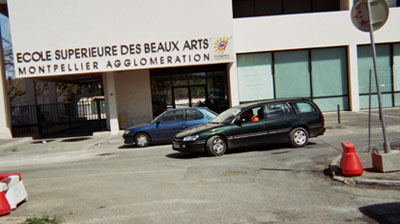
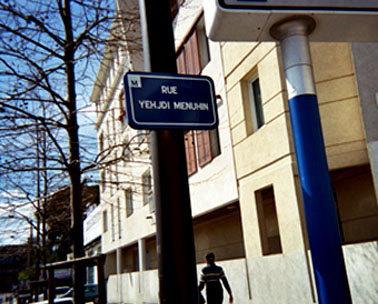
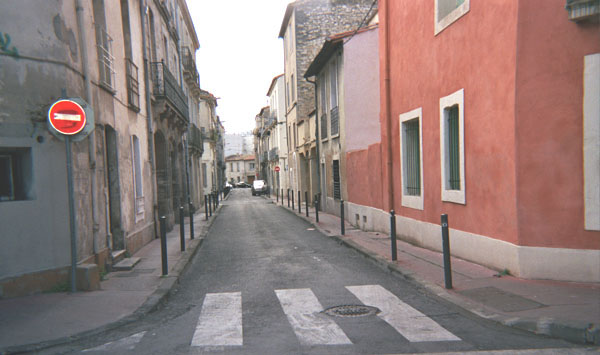
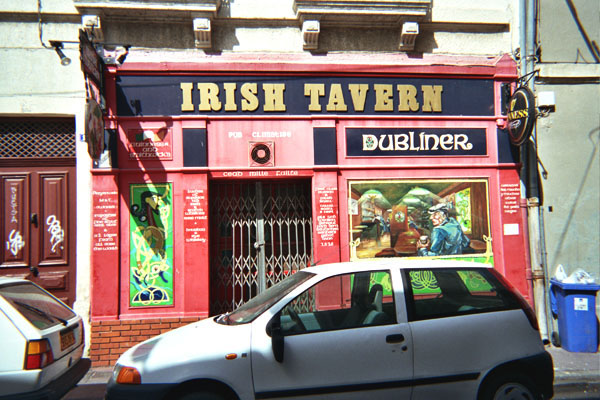
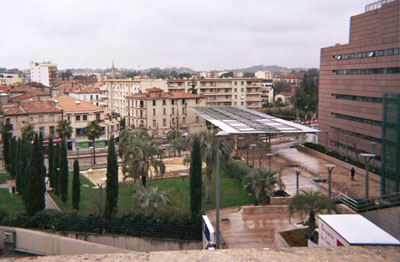
My purpose in going out to the university was to look up an old acquaintance, Eric Terouanne. Back in 1988 during my search for Alexander Grothendieck, he and Christian Maillol, a Chilean political exile, both faculty members in the mathematics department, gave me directions to AG's private hermitage, (since abandoned) . Worlds away from the charming and durable old buildings of the Old City, those of the University Paul Valery are long and squat. Both interior and exterior are ugly; I can't imagine anyone every feeling comfortable trying to learn anything in them. They're very much in the style of American community colleges, with buildings made from cheap materials designed to last a few years thrown up in a hurry.
The "Humanities" campus and the "Sciences" campus are virtually two separate universities! ( C.P. Snow would have had a field day). I went first to the Sciences campus, which is where I'd encountered Eric and Christian. The Tramway stops some distance away from either campus and the geography in this district is confusing for someone who doesn't know his way around. I had to ask several people for the way to the campus, and ended up crawling through a hole in a broken chain link fence.
Mathematics occupies a building to itself. This isn't because the department is particularly distinguished, (despite the years of Grothendieck's presence there), but because of the frightful emergence of Computer Science as an autonomous discipline hanging like a mushroom cloud over the ruins of basic math education. Montpellier is a center for computer technology, and maintains an active relationship with IBM headquarters in Poughkeepsie, NY. Visiting the campus for the first time in 1988 I ran into people who knew acquaintances of mine in the Hudson Valley, a very small world indeed.
The name "Eric Terouanne" meant nothing to the secretaries in the math department. He may have been teaching there in the 80's, but that was a long time again. Purely by chance, I ran into someone in the department who told me that his new office was on the Humanities campus, half a mile away. I went back out into the rain, crossed a highway, asked for directions from two more people and found myself before a new kingdom with its own customs and mores.
For some reason I'd gotten it into my head that there had to be an independent mathematics department for humanities majors on this campus. No-one I spoke with had ever heard of such a thing and, of course, it didn't exist.
There is a story that in a conversation with Albert Einstein, Paul Valery asked him if he kept notebooks around to write down ideas he might otherwise forget. Einstein explained that in his field, good ideas came so rarely that one wasn't likely to forget them.
I roamed through dark, unfriendly, corridors of odd buildings entered through parti-colored doors, with adjunct modules shaped like spaceship decompression chambers, staircases that seemed to trail off to nowhere, auditoriums in the middle of nothing, until, by knocking on many doors I found someone who looked up Eric's name and office number in the university bulletin.
We did find his address. Locating his building required a separate trip to a low-lying administration building. The receptionist there was no ruder than one was prepared to encounter. Grudgingly she indicated the way to his office. The building was close by. Eric's office was on the 3rd floor. To my great surprise I found myself in the department of Portuguese language and literature!
In the 14 years since we'd met, Eric Terouanne, ( his name unimpeachably stencilled in bold letters on his door) had migrated from Mathematics to teaching his native language! He wasn't in, but a colleague in a neighboring office gave me his home phone number, the same one he'd had me back in 1988. I called him up later that evening. He was busy with last minute preparations to leave the next day with his family on their Easter vacation, so he wasn't able to invite me over. A long conversation over the telephone enabled both of us to catch up on the last decade and a half.
Montpellier, Saturday March 26: It rained for most of the day, a sharp, impenitent drizzle, never swelling to a downpour, nor dying away. A trip to the central post office to exchange currency led me through a dismal neighborhood Montpellier, decidedly less historical or romantic, with little in the way of showcase architecture, though bustling with heavy traffic . No fee is charged for money exchanged at the Post Office and the official government rate was better than what was being offered at the banks. My anxiety had exaggerated the fall. Throughout this visit to France the exchange rate always hovered around 3 Euros for 4 Dollars. The rest of the morning was taken up with small routine tasks: filling out and sending post-cards, picking up a new notebook, assembling items for lunch from the public markets.
At noon I took the Tramway out to the Zola library again. Despite a 300-year tradition of fulminating French anti-clericalism, it was closed, a day early, in honor of Easter. I was happy to give its personnel, ( who dedicate themselves body and soul to preserving and transmitting the accumulated wisdom of the ages) , a well-merited vacation. But how I going to fill my time over this rainy holiday weekend!
An outlying village, St. Juan de Vedas, had been recommended to me as a place where one found beautiful landscapes, caves, some old churches and a theater. There were buses going out there, departing from the gare routière , about 4 blocks from the train station. After walking through and climbing blocks of industrial waste and abandoned construction, one comes to a seedy densely polluted parking area. A complicated comedy of errors ensued in which, despite hanging around for two hours, I missed the connection I needed; I was told I'd have to wait another two hours for the next one. Furthermore, that was the final bus of the day; I would be able to spend at most 20 minutes in St. Juan de Vedas.
It was already 3 PM. With nothing better to do, I walked back to the official Tourist Office, temporarily located in an elegant hotel near the train station. I was in luck: a guided tour, in English, of the Old City was scheduled for 3:30 at the reasonable price of 5 Euros. When all the participants finally assembled, the tour consisted of tourists from England, Holland and Norway. I believe I was the only American.
The guide was, I would hazard a guess, a woman up in her 50's, overflowing with wit, friendliness and Gallic charm with, I suspect, a background in theater or musical comedy. Not much more than 5 feet, with black hair and a long, flat face, she spoke with wide expansive gestures an effective if far from perfect English.
Place de la Comedie

The guided tour in the rain
Although the rain never stopped throughout our stroll, she neither carried an umbrella nor wore a raincoat. She is very well-versed in the history of Montpellier and clearly loves the city. Montpellier celebrated its millennium in 1995 ; a great deal has happened here in the last 1000 years .
Old Montpellier
The founder of Montpellier in the year 995 was a certain King Guilhem of Aragon; Guilhems ruled here for 8 generations. Its sources of prosperity were the wine-growing region to the north and the pilgrim's roads to the shrine of Santiago de Compostella to the south. In fact the old pilgrim's road passes directly through the Place de la Comedie. For over 300 years it was allied with the kingdom of Aragon and other royal houses of Spain. It became integrated into French territory in 1346, when it was purchased by the notoriously bad king, Louis Onze for some enormous sum of money. The date of purchase coincides with the worst part of the Hundred Years War, but there wasn't much fighting in this region.
There are no forests in or around Montpellier and stone construction is the rule for all medieval buildings. We were led through streets holding department stores and restaurants. Through their display windows one can see the stone vaults that shapes of the old structures.
Many of these buildings are very handsome.
An elegant residence
Place Petrarch
but a destructive pestilence of juvenile graffiti has disfigured virtually every exterior in sight.
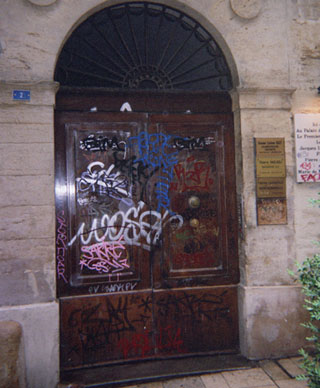
Montpellier Graffiti
"Art" is not validated through its mutilation of other art. I am not hostile to graffiti in other contexts, yet I was frankly revolted by the callous contempt for beauty and craft which has had the bad luck to be ancient.
Montpellier has always been distinguished as a center of learning, science and medicine.
College of Surgery, 18th century
This was due in part to the close proximity of Arab and Moorish kingdoms, where Moslems, Jews and Christians worked in perfect harmony during the golden ages of Islamic civilization. The reign of the Guilhems was exceptional for its tolerance in an age that scarcely understood the meaning of the word. Not only did Jews occupy high offices in the government, they were allowed to live anywhere in the city, even in streets adjacent to the palace.
The guide took us to the site of a recently discovered medieval Mikva, or religious bath house for the Orthodox Jewish women. The menfolk graciously built it for them so that they could periodically wash the sin off their bodies.
12th century Mikva
Henry IV, the Huguenot king of the 16th century, came from Montpellier. Until the religious persecution unleashed by Louis XIV, Montpellier was one of the great intellectual centers of Protestant Europe. Students arrived here from all parts of the Germanic world. Louis XIV relentless pursued the Huguenots for 60 years, by which time all Protestants had either been murdered, converted by force, or sent into exile. Not content merely to kill them off, Louis dispatched squads of Jesuits and "black nuns" to pacify the region.
Street of the black nuns
